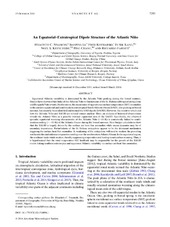| dc.contributor.author | Nnamchi, Hyacinth C | |
| dc.contributor.author | Li, Jianping | |
| dc.contributor.author | Kucharski, Fred | |
| dc.contributor.author | Kang, In-Sik | |
| dc.contributor.author | Keenlyside, Noel | |
| dc.contributor.author | Chang, Ping | |
| dc.contributor.author | Farneti, Riccardo | |
| dc.date.accessioned | 2016-11-25T09:57:33Z | |
| dc.date.available | 2016-11-25T09:57:33Z | |
| dc.date.issued | 2016 | |
| dc.Published | Journal of Climate 2016:7295-7311 | eng |
| dc.identifier.issn | 1520-0442 | en_US |
| dc.identifier.uri | https://hdl.handle.net/1956/13117 | |
| dc.description.abstract | Equatorial Atlantic variability is dominated by the Atlantic Niño peaking during the boreal summer. Studies have shown robust links of the Atlantic Niño to fluctuations of the St. Helena subtropical anticyclone and Benguela Niño events. Furthermore, the occurrence of opposite sea surface temperature (SST) anomalies in the eastern equatorial and southwestern extratropical South Atlantic Ocean (SAO), also peaking in boreal summer, has recently been identified and termed the SAO dipole (SAOD). However, the extent to which and how the Atlantic Niño and SAOD are related remain unclear. Here, an analysis of historical observations reveals the Atlantic Niño as a possible intrinsic equatorial arm of the SAOD. Specifically, the observed sporadic equatorial warming characteristic of the Atlantic Niño (~0.4 K) is consistently linked to southwestern cooling (~−0.4 K) of the Atlantic Ocean during the boreal summer. Heat budget calculations show that the SAOD is largely driven by the surface net heat flux anomalies while ocean dynamics may be of secondary importance. Perturbations of the St. Helena anticyclone appear to be the dominant mechanism triggering the surface heat flux anomalies. A weakening of the anticyclone will tend to weaken the prevailing northeasterlies and enhance evaporative cooling over the southwestern Atlantic Ocean. In the equatorial region, the southeast trade winds weaken, thereby suppressing evaporation and leading to net surface warming. Thus, it is hypothesized that the wind–evaporation–SST feedback may be responsible for the growth of the SAOD events linking southern extratropics and equatorial Atlantic variability via surface net heat flux anomalies. | en_US |
| dc.language.iso | eng | eng |
| dc.publisher | American Meteorological Society | en_US |
| dc.subject | Geographic location/entity | eng |
| dc.subject | Atlantic Ocean | eng |
| dc.subject | Circulation/ Dynamics | eng |
| dc.subject | Atmosphere-ocean interaction | eng |
| dc.subject | Ocean dynamics | eng |
| dc.subject | Physical Meteorology and Climatology | eng |
| dc.subject | Fluxes | eng |
| dc.subject | Mathematical and statistical techniques | eng |
| dc.subject | Statistics | eng |
| dc.subject | Variability | eng |
| dc.subject | Interannual variability | eng |
| dc.title | An Equatorial–Extratropical Dipole Structure of the Atlantic Niño | en_US |
| dc.type | Peer reviewed | |
| dc.type | Journal article | |
| dc.date.updated | 2016-10-19T17:45:54Z | |
| dc.description.version | publishedVersion | en_US |
| dc.rights.holder | Copyright 2016 American Meteorological Society (AMS). Permission to use figures, tables, and brief excerpts from this work in scientific and educational works is hereby granted provided that the source is acknowledged. Any use of material in this work that is determined to be “fair use” under Section 107 of the U.S. Copyright Act September 2010 Page 2 or that satisfies the conditions specified in Section 108 of the U.S. Copyright Act (17 USC §108, as revised by P.L. 94-553) does not require the AMS’s permission. Republication, systematic reproduction, posting in electronic form, such as on a web site or in a searchable database, or other uses of this material, except as exempted by the above statement, requires written permission or a license from the AMS. Additional details are provided in the AMS Copyright Policy, available on the AMS Web site located at (https://www.ametsoc.org/) or from the AMS at 617-227-2425 or copyrights@ametsoc.org. | en_US |
| dc.identifier.doi | https://doi.org/10.1175/jcli-d-15-0894.1 | |
| dc.identifier.cristin | 1387893 | |
| dc.relation.project | EU: 603521 | |
| dc.relation.project | Norges forskningsråd: 233680 | |
